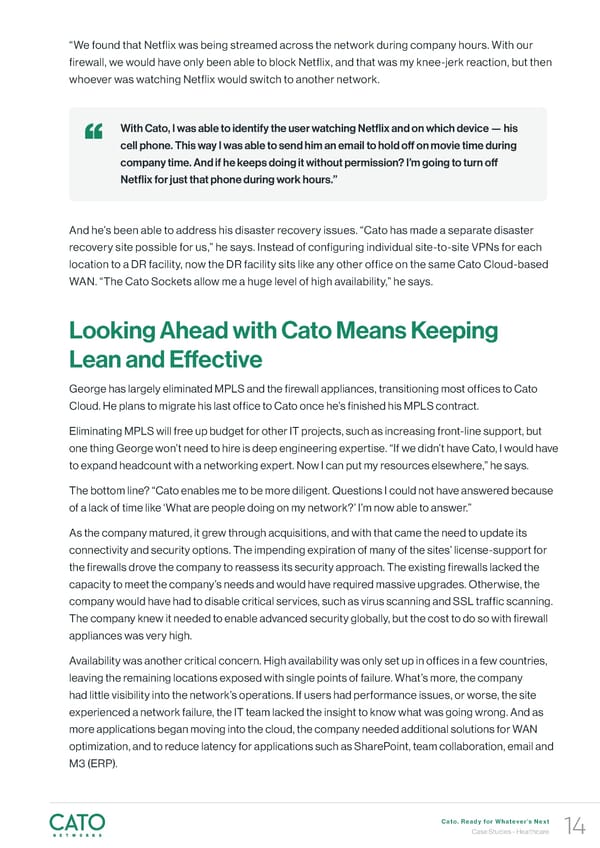“We found that Netflix was being streamed across the network during company hours. With our firewall, we would have only been able to block Netflix, and that was my knee-jerk reaction, but then whoever was watching Netflix would switch to another network. With Cato, I was able to identify the user watching Net昀氀ix and on which device — his cell phone. This way I was able to send him an email to hold o昀昀 on movie time during company time. And if he keeps doing it without permission? I’m going to turn o昀昀 Net昀氀ix for just that phone during work hours.” And he’s been able to address his disaster recovery issues. “Cato has made a separate disaster recovery site possible for us,” he says. Instead of configuring individual site-to-site VPNs for each location to a DR facility, now the DR facility sits like any other office on the same Cato Cloud-based WAN. “The Cato Sockets allow me a huge level of high availability,” he says. Looking Ahead with Cato Means Keeping Lean and E昀昀ective George has largely eliminated MPLS and the firewall appliances, transitioning most offices to Cato Cloud. He plans to migrate his last office to Cato once he’s finished his MPLS contract. Eliminating MPLS will free up budget for other IT projects, such as increasing front-line support, but one thing George won’t need to hire is deep engineering expertise. “If we didn’t have Cato, I would have to expand headcount with a networking expert. Now I can put my resources elsewhere,” he says. The bottom line? “Cato enables me to be more diligent. Questions I could not have answered because of a lack of time like ‘What are people doing on my network?’ I’m now able to answer.” As the company matured, it grew through acquisitions, and with that came the need to update its connectivity and security options. The impending expiration of many of the sites’ license-support for the firewalls drove the company to reassess its security approach. The existing firewalls lacked the capacity to meet the company’s needs and would have required massive upgrades. Otherwise, the company would have had to disable critical services, such as virus scanning and SSL traffic scanning. The company knew it needed to enable advanced security globally, but the cost to do so with firewall appliances was very high. Availability was another critical concern. High availability was only set up in offices in a few countries, leaving the remaining locations exposed with single points of failure. What’s more, the company had little visibility into the network’s operations. If users had performance issues, or worse, the site experienced a network failure, the IT team lacked the insight to know what was going wrong. And as more applications began moving into the cloud, the company needed additional solutions for WAN optimization, and to reduce latency for applications such as SharePoint, team collaboration, email and M3 (ERP). Cato. Ready for Whatever’s Next Case Studies - Healthcare 14
 Cato Networks Healthcare Page 13 Page 15
Cato Networks Healthcare Page 13 Page 15